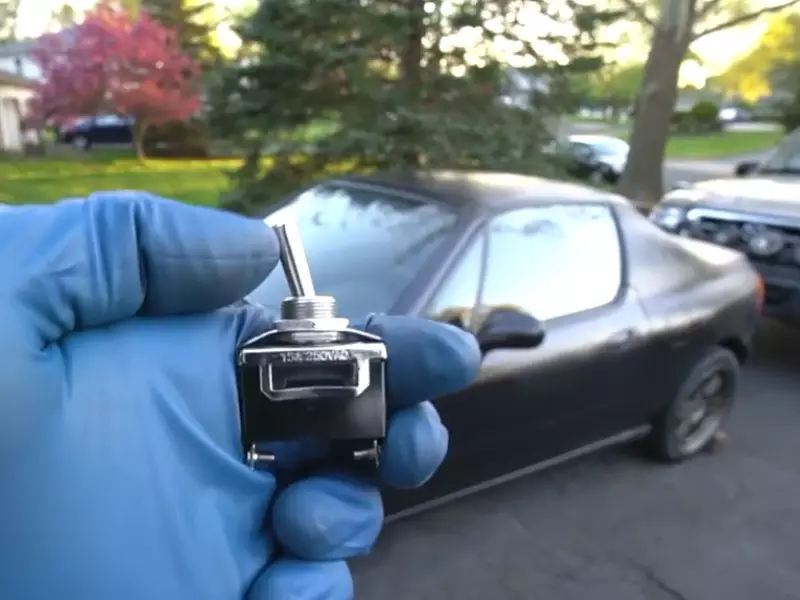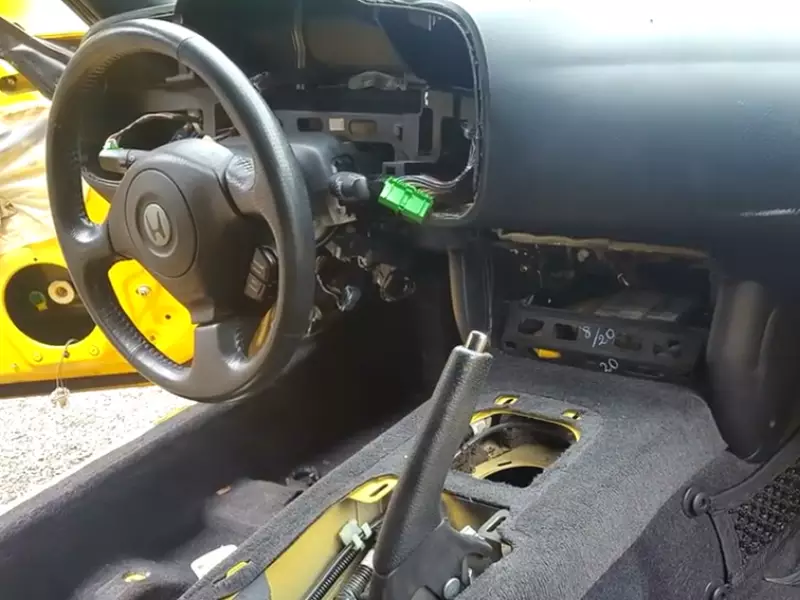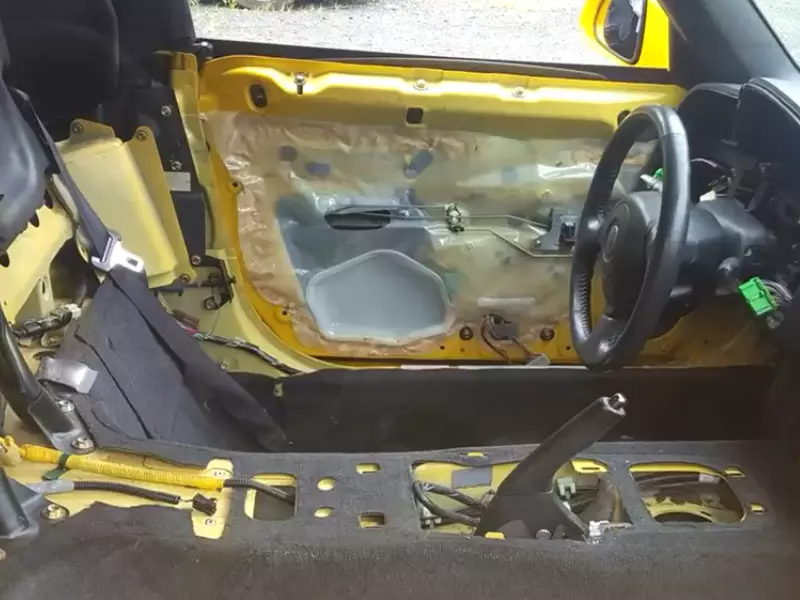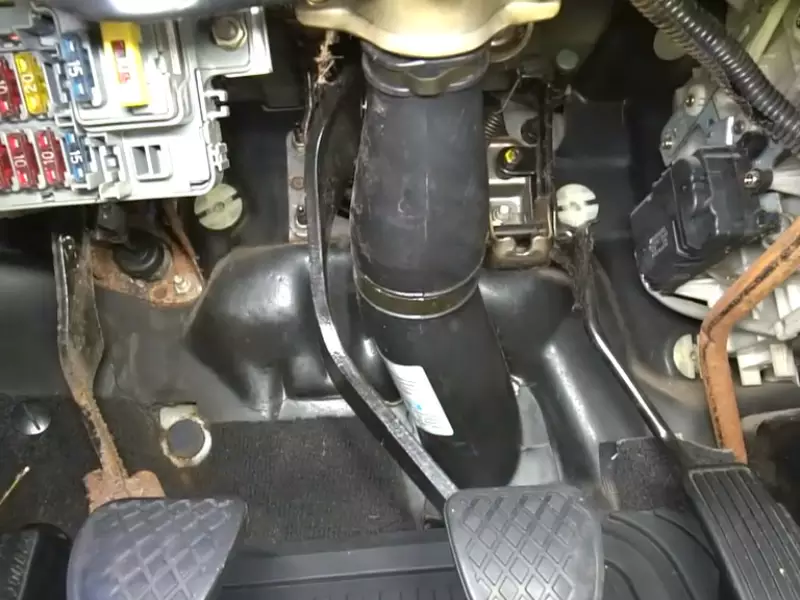To install a kill switch on a car, you will need to disconnect the ignition switch and install a toggle switch or button to disable the vehicle’s circuit. This will prevent the car from starting without the switch being in the proper position.
By installing a kill switch, you can add an extra layer of security to your vehicle and deter potential thieves from stealing it. When it comes to car security, a kill switch can be a simple and effective solution. It adds an extra layer of protection to your vehicle and gives you peace of mind.
We will guide you through the process of installing a kill switch on your car. With basic mechanical knowledge and a few tools, you can easily install a kill switch and enhance the security of your vehicle. Let’s dive in and learn how to install a kill switch on a car.

Understanding The Purpose Of A Kill Switch
What is a kill switch and why is it important?
Before we delve into the installation process, it’s important to understand what a kill switch is and why it is essential for car security. A kill switch is a device that can disable the engine of a vehicle, preventing it from starting or running. It serves as an additional layer of security, deterring potential car thieves and providing peace of mind for car owners.
How does a kill switch work to enhance car security?
Now that you know what a kill switch is, let’s explore how it works to enhance car security. When a kill switch is installed in a car, it creates a hidden, secondary circuit that controls the ignition system or fuel pump. This secondary circuit is connected to a switch or button that only the car owner possesses or knows about. By activating the kill switch, the car owner can prevent unauthorized individuals from starting and operating the vehicle.
The beauty of a kill switch lies in its stealthy nature. Since it is concealed within the vehicle, potential thieves won’t even know it exists, making it an effective deterrent against theft. Moreover, even if a thief manages to start the car, they will be greeted by an unexpected engine shutdown when they unknowingly trigger the kill switch.
Installing a kill switch on your car not only provides an additional layer of security, but it can also potentially save you money on insurance premiums. Many insurance companies offer discounts to car owners who have anti-theft devices installed, including kill switches. By taking proactive measures to protect your vehicle, you can reduce the risk of theft and enjoy the financial benefits that come with it.
In conclusion, a kill switch is an invaluable tool for enhancing car security. By understanding its purpose and learning how it works, car owners can make informed decisions about installing one on their vehicles. Whether you live in a high-risk area or simply want to add an extra layer of protection, a kill switch offers peace of mind and an effective deterrent against theft.
Assessing Your Car’S Wiring System
Before installing a kill switch on your car, it is important to assess your car’s wiring system to ensure a smooth installation process. Identifying the appropriate wires to connect the kill switch to and understanding the car’s electrical system are vital steps to take. Additionally, taking necessary safety precautions will help you prevent any mishaps during the installation.
Identifying the Appropriate Wires to Connect the Kill Switch To
When it comes to installing a kill switch on your car, it is crucial to identify the appropriate wires to connect the switch to. This will ensure that the kill switch functions effectively in cutting off power to the engine when necessary. Here are a few steps to help you with this process:
- Refer to your car’s owner manual or wiring diagram to locate the wires related to the ignition system. These wires can vary depending on the make and model of your car.
- Once you have identified the ignition-related wires, use a multimeter to test each wire’s voltage. This will help you differentiate between the wires that are hot (carrying voltage) and those that are not.
- Next, you will need to connect the kill switch to the appropriate ignition wire. This can be done by cutting into the wire and attaching the kill switch in series with it. Make sure to follow the manufacturer’s instructions for proper installation.

Understanding the Car’s Electrical System and Safety Precautions
Installing a kill switch involves interacting with your car’s electrical system, so it is crucial to have a good understanding of how it works and take the necessary safety precautions. Here are a few important points to keep in mind:
- Prior to any work on your car’s electrical system, it is crucial to disconnect the battery to avoid any accidental shocks or short-circuits.
- Take the time to familiarize yourself with your car’s electrical components and their key functions. This will help you navigate the wiring system more efficiently and reduce the risk of making mistakes.
- Handle all wires and connections with care to prevent any damage or accidental disconnections.
- Remember to use appropriate insulation materials, such as heat shrink tubing, to protect and secure the newly connected wires. This will prevent any potential shorts or electrical hazards.
- After installing the kill switch, test it thoroughly to ensure it functions as intended. This involves starting the car with the switch in the “off” position and ensuring the engine does not start.
By understanding your car’s electrical system and taking necessary safety precautions, you can install a kill switch on your car confidently and effectively. Remember to always consult your car’s manual or seek professional assistance if you are uncertain about any steps during the installation process.
Selecting And Installing The Kill Switch
Installing a kill switch on your car is a smart security measure that can help prevent theft. A kill switch is a device that cuts off the electrical power to your car’s ignition system, making it impossible to start the engine. In this guide, we will explore the process of selecting and installing the right kill switch for your car.
Researching different types of kill switches available
Before installing a kill switch on your car, it’s essential to research the different types of kill switches available in the market. This will help you choose the one that best suits your requirements. There are various types of kill switches, including toggle switches, push-button switches, and hidden switches.
Toggle switches are simple and easy to use. They have an on/off lever that allows you to control the power supply to the ignition system. Push-button switches, on the other hand, require you to press a button to cut off the electrical supply to the ignition system. Hidden switches are installed in inconspicuous locations within the car, making them difficult for potential thieves to find.
Consider the pros and cons of each type of kill switch and choose the one that aligns with your needs and preferences. It’s important to ensure that the kill switch you select is compatible with your car’s make and model.
Choosing the right kill switch for your car’s make and model
When selecting a kill switch for your car, it’s crucial to choose one that is compatible with your car’s make and model. This will ensure a seamless installation process and optimal functionality. Different car models may require specific wiring configurations, so it’s essential to consult your car’s manual or seek professional advice to ensure compatibility.
Additionally, consider the quality and reliability of the kill switch. Look for trusted brands and read customer reviews to get an idea of the performance and durability of the product. Investing in a high-quality kill switch will provide better security for your vehicle.

Step-by-step installation guide for the kill switch
Once you have selected the right kill switch for your car, it’s time to proceed with the installation. Follow these step-by-step instructions to install the kill switch:
- Begin by disconnecting the negative terminal of the car battery to ensure safety during the installation process.
- Locate the ignition switch in your car. This is usually located on the steering column or dashboard.
- Identify the wires connected to the ignition switch. Refer to your car’s manual or wiring diagram to determine the correct wires.
- Cut the wire that supplies power to the ignition system. This is the wire that needs to be interrupted by the kill switch.
- Connect the wires of the kill switch to the wire that you have cut. Ensure proper insulation and secure connections using electrical tape or wire connectors.
- Mount the kill switch at a convenient yet discreet location. This may vary depending on the type of kill switch you have chosen.
- Test the kill switch by reconnecting the car battery’s negative terminal and attempting to start the car. The engine should not start when the kill switch is in the off position.
- Once you have verified the functionality of the kill switch, reassemble any disassembled parts and ensure that the installation is neat and secure.
By following these steps, you can successfully install a kill switch in your car, enhancing its security and deterring potential thieves.
Testing And Troubleshooting
After successfully installing a kill switch on your car, it’s crucial to test its functionality and address any potential issues that may arise. This step ensures the effectiveness of the switch and provides peace of mind when it comes to the security of your vehicle. In this section, we will discuss how to test the functionality of the kill switch, common issues you may encounter, and how to troubleshoot them.
Testing the functionality of the kill switch
To ensure the kill switch is working as intended, follow these steps:
- Start by activating the kill switch and turning the ignition key to the “On” position. The engine should not start. This test verifies that the switch is cutting off the power supply to the engine.
- Next, deactivate the kill switch and try starting the vehicle. The engine should start normally. This test confirms that the switch restores power to the engine when deactivated.
- Repeat these steps a few times to double-check the functionality of the kill switch. It’s important to ensure that the switch consistently prevents the engine from starting when activated and allows the engine to start when deactivated.
Common issues and how to troubleshoot them
During the testing process, you may encounter a few common issues. Here are some troubleshooting tips to help you address them:
| Issue | Troubleshooting |
|---|---|
| The engine fails to start even when the kill switch is deactivated. | Check the kill switch connections to ensure they are secure. Make sure the wiring is not loose or damaged. If necessary, tighten or replace the wiring accordingly. |
| The engine starts even when the kill switch is activated. | Verify that the kill switch installation was done correctly and that all connections are properly made. Double-check the wiring to ensure there are no loose connections or exposed wire. If needed, re-install or replace the kill switch. |
| The kill switch does not activate or deactivate consistently. | Inspect the switch mechanism to ensure it is functioning correctly. If there are any signs of wear or damage, replace the switch with a new one. Additionally, check the wiring connections to ensure they are secure and not causing any interruptions. |
Ensuring the kill switch is functioning optimally after installation
Once you have tested the kill switch and resolved any issues, it’s important to ensure it continues to function optimally. Consider the following tips:
- Regularly inspect the kill switch and surrounding wiring for any signs of wear or damage. Address any issues promptly to prevent potential malfunctions.
- Perform regular tests to confirm that the kill switch is still preventing the engine from starting when activated and restoring power when deactivated.
- Keep the kill switch hidden and protected to prevent tampering or accidental activation. This will help maximize the security of your vehicle.
By testing the functionality of the kill switch, troubleshooting any issues, and following these maintenance tips, you can ensure that your kill switch is in optimal working condition after installation. Always prioritize the security of your vehicle to protect against theft and unauthorized use.

Additional Security Measures
Exploring other car security options
If you’re concerned about the safety of your vehicle, installing a kill switch is a fantastic first step. However, there are additional security measures you can take to further protect your car from potential theft. Let’s explore a few other car security options that can complement the kill switch:
- Car alarm system: Installing a car alarm system can be an effective deterrent for thieves. The loud siren and flashing lights provide a visible and audible warning, alerting both you and those nearby of any unauthorized access to your vehicle.
- Steering wheel lock: A steering wheel lock is a physical device that adds an extra layer of security to your car. It prevents the steering wheel from turning, making it difficult for a thief to drive away even if they manage to start the engine.
- GPS tracking system: In the unfortunate event that your car does get stolen, a GPS tracking system can help you locate it. These systems use satellite technology to pinpoint the exact location of your vehicle, allowing you to inform the authorities and recover your car quickly.
- Locking lug nuts: One common technique thieves use is changing the wheels on a stolen vehicle. By installing locking lug nuts, you can make it much more challenging for them to remove the wheels and abandon the car or sell its parts.
Tips for maximizing car security
While each of these security options provides some level of protection, here are a few tips to maximize your car’s security:
- Park in well-lit areas: Thieves are less likely to attempt a break-in or theft in areas that are well-lit, as they are more likely to be spotted. Whenever possible, park your car in well-lit areas, preferably under streetlights or near CCTV cameras.
- Secure your valuables: Don’t leave tempting items, such as laptops, smartphones, or bags, visible in your car. Secure them in the trunk or take them with you to minimize the risk of theft.
- Use a steering wheel lock: Even if you have a kill switch installed, a steering wheel lock can provide an extra layer of physical security.
- Utilize multiple security measures: Combining different security options, such as a kill switch, car alarm system, and steering wheel lock, can significantly reduce the risk of theft.
Integrating the kill switch with existing security systems
When it comes to car security, it’s essential to ensure that all your systems work together seamlessly. Integrating the kill switch with other existing security measures can provide a comprehensive and robust defense against potential thefts. Here are a few steps to follow to integrate the kill switch with your existing security systems:
- Consult a professional: Before making any modifications, consult a professional automotive electrician or mechanic. They can guide you on the best way to integrate the kill switch into your car’s electrical system.
- Locate the right wires: Identify the ignition and fuel pump wires in your car’s wiring harness. These are the wires you will need to cut and connect to the kill switch.
- Connect the kill switch: Install the kill switch by connecting the ignition wire to one terminal and the fuel pump wire to another. This will allow you to cut the power supply to both the ignition and fuel pump, effectively immobilizing the vehicle.
- Test the system: Once the kill switch is installed, test it to ensure it functions correctly. Start the car with the switch in the OFF position, and it should not start. Then, turn the switch ON, and the car should start without any issues.
- Integrate with alarm system (optional): If you have a car alarm system installed, you may be able to integrate the kill switch with it. This can provide an added layer of security, as the alarm will be triggered if anyone attempts to tamper with or start the car without deactivating the kill switch.
By exploring other car security options, following tips for maximizing car security, and integrating the kill switch with existing security systems, you can significantly enhance the protection of your vehicle. Take these steps to safeguard your car and enjoy the peace of mind that comes with knowing your vehicle is secure.
Frequently Asked Questions On How To Install A Kill Switch On A Car
Can I Put A Kill Switch On My Car?
Yes, you can install a kill switch on your car. A kill switch is a safety mechanism that can be added to your vehicle to prevent unauthorized starting or operation. It can be useful in deterring theft and increasing security.
Consulting a professional installer is recommended for proper installation and functionality.
Can You Install Kill Switch Yourself?
Yes, you can install a kill switch yourself.
How Much Does It Cost To Install A Kill Switch In A Car?
Installing a kill switch in a car can cost around $100 to $500. The price may vary depending on the make and model of the vehicle, as well as the complexity of the installation process. It is recommended to consult with a professional to get an accurate cost estimate.
Where Is The Best Place To Put A Kill Switch In A Car?
The best place to install a kill switch in a car is near the ignition system. This allows for easy access and provides optimum security against unauthorized use.
Conclusion
Installing a kill switch on your car is a smart way to enhance its security. By following the step-by-step guide provided in this blog post, you can effectively prevent unauthorized access and potential theft. Remember to consult your car’s manual and seek professional help if needed.
Adding a kill switch is a proactive measure that offers peace of mind and protects your valuable investment. Stay safe on the roads!
